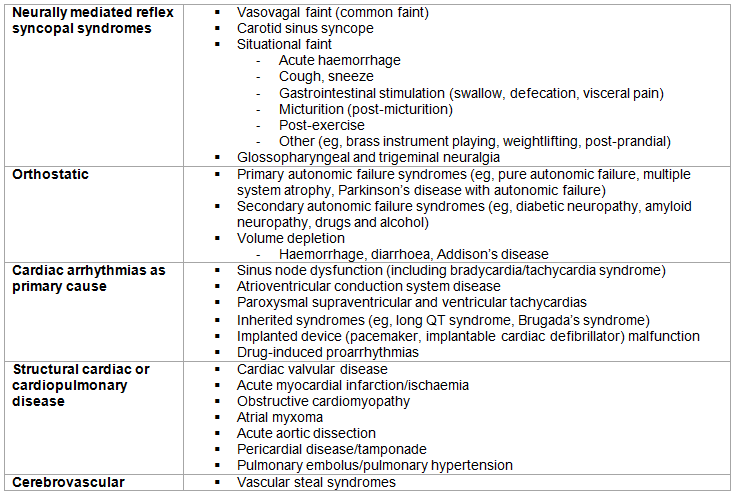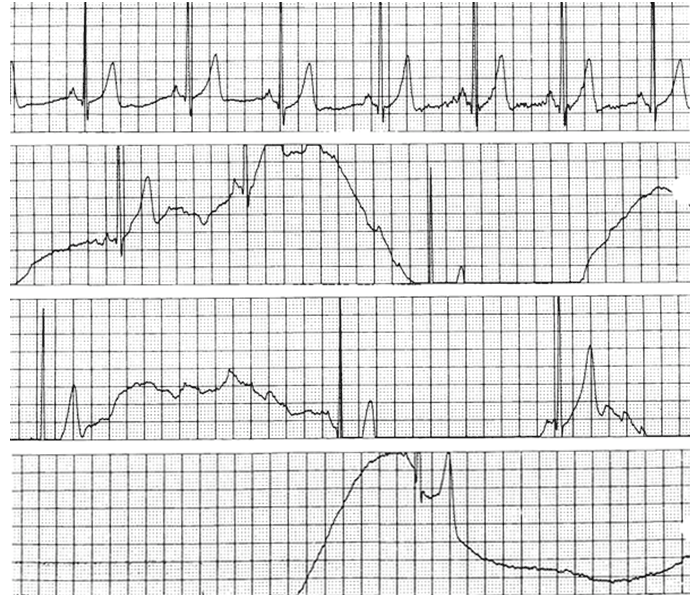Aetiology
Syncope has many possible causes, which are commonly categorised into three main groups: neurally mediated reflex syncopal syndromes, orthostatic, or cardiovascular. However, even after a thorough assessment, it may not be possible to assign a single cause for fainting. Patients often have multiple comorbidities, and as a consequence they may have several equally probable causes of fainting. For example, while people with severe heart disease may experience transient tachyarrhythmias, high-grade atrioventricular block, or even adverse effects from the use of multiple medications, they are also potential candidates for vasovagal faints.[19]
NMRS syndromes include vasovagal faint (common faint), carotid sinus syncope, situational faint, and glossopharyngeal and trigeminal neuralgia. These neurally mediated reflex faints, especially the vasovagal faint, are the most common causes of syncope overall and are particularly prevalent in people without evidence of underlying heart disease or vascular disease.
In susceptible people, vasovagal syncope may be triggered by prolonged periods of upright posture; relative dehydration; excessively warm, closed-in environments; or extreme emotions. Common places for these events are churches, restaurants, and long queues.
Pathophysiology
Transient insufficiency of global cerebral nutrient flow is the common thread underlying the mechanism of all forms of syncope.[2] Thus, transient reduction of blood oxygen content (e.g., as in acute aircraft decompression) may cause a faint. However, by far the most common aetiology is diminished cerebral perfusion resulting from a transient decrease in arterial blood pressure (BP), such as might occur at the onset of a tachycardia or in conjunction with a prolonged pause in the cardiac rhythm. Loss of postural tone is an inevitable consequence of loss of consciousness, and if the patient is not restrained, the person will slump over or fall to the ground. Furthermore, on occasion, control of non-skeletal muscles may be affected, resulting for instance in bladder (common) or bowel (rare) incontinence. Only later in the faint, as cerebral oxygen deprivation reaches its most severe state, do jerky muscular movements occur in many (but not all) patients who faint. These movements start after the loss of consciousness, are brief in duration, and are erratic, thereby being distinguishable from the tonic-clonic movements of a classic epileptic seizure.
In healthy young people, cerebral blood flow represents 12% to 15% of resting cardiac output. (i.e., 50 to 60 mL/100 g of brain tissue per minute).[20][21] A flow of this magnitude readily meets the minimum oxygen requirement to sustain consciousness (3.0 to 3.5 mL oxygen/100 g tissue per minute). However, the safety factor for oxygen delivery may be lower in older people and those with diabetes mellitus or hypertension.[22] A sudden cessation of cerebral blood flow for only 6 to 10 seconds is sufficient to cause complete loss of consciousness. Further, experience with tilt-table testing has indicated that a sustained decrease in systolic BP to 60 mmHg or lower leads to syncope.
Cerebral blood flow is normally well autoregulated, but, nevertheless, integrity of cerebral nutrient flow depends on mechanisms that maintain systemic pressure. The most important of these are:
Arterial baroreceptor-induced adjustments of systemic vascular resistance, cardiac contractility, and heart rate
Intravascular volume regulation, incorporating renal and hormonal influences to maintain central blood volume
Autonomic control over systemic BP
Cerebrovascular autoregulation, which permits cerebral blood flow to be maintained over a relatively wide range of perfusion pressures.
Transient failure of protective mechanisms, often aggravated by iatrogenic factors such as vasodilator drugs, diuretics, or by medical issues such as dehydration or haemorrhage, may reduce systemic BP below the autoregulatory range and could induce a syncopal episode. Risk of failure of normal protective compensatory mechanisms is greatest in patients who are older or ill and those with various forms of autonomic failure.
Classification
Causes of syncope
Syncope has many possible causes, which are commonly categorised into three main groups: neurally mediated reflex syncopal (NMRS) syndromes, orthostatic, or cardiovascular.
[Figure caption and citation for the preceding image starts]: Classification of syncopeFrom personal collection of Dr David Benditt; used with permission [Citation ends].
NMRS syndromes
NMRS syndromes include vasovagal faint (common faint), carotid sinus syncope, situational faint, and glossopharyngeal and trigeminal neuralgia.
Orthostatic syncope (postural or orthostatic intolerance syncope syndromes)
Orthostatic (postural) faints are common and are most often associated with movement from lying or sitting to a standing position.
While orthostatic hypotension (OH) is not considered part of the NMRS, a neural component is a major contributor to its pathophysiology; differentiating OH from NMRS in the clinic is a common problem.[2][3][4]
Cardiac arrhythmias as primary cause of syncope
Cardiac arrhythmias as the primary cause of syncope (i.e., those not secondary to neural-reflex events) are less frequent than either neurally mediated reflex faints or OH.[2] However, they are an important differential as they are often associated with a poorer prognosis.
[Figure caption and citation for the preceding image starts]: Ambulatory monitoring recording obtained during a spontaneous faint associated with marked bradycardia. Baseline movement reflects the patient's distressFrom personal collection of Dr David Benditt; used with permission [Citation ends]. [Figure caption and citation for the preceding image starts]: ECG trace revealing an episode of torsades de pointes in a patient with recurrent faints and evident long-QT syndromeFrom personal collection of Dr David Benditt; used with permission [Citation ends].
[Figure caption and citation for the preceding image starts]: ECG trace revealing an episode of torsades de pointes in a patient with recurrent faints and evident long-QT syndromeFrom personal collection of Dr David Benditt; used with permission [Citation ends].
Structural cardiac or cardiopulmonary disease
Structural cardiopulmonary diseases are relatively infrequent causes of faints compared with the neural-reflex, orthostatic faints, or syncope due to arrhythmia.[2][3] However, it is important to recognise faints associated with structural heart disease or vascular disease, because they warn of potentially life-threatening conditions.[2][5][6]
Cerebrovascular disease and related conditions
Cerebrovascular disease is almost never the cause of a true faint, meaning loss of consciousness due to cerebral hypoperfusion without focal neurological deficit. In fact, transient ischaemic attacks (TIAs) are the opposite: focal deficit without loss of consciousness.[2][7]
Subclavian steal is the best example in this class but is uncommon.[2] As a rule, this category should be considered only after other causes have been eliminated.
Migraine-related syncope might also be included in this category. However, most syncope in patients with migraine is vasovagal in origin, possibly triggered by pain.[2][8] Syncope due to massive cerebrovascular spasm appears to be very rare.
Syncope mimics and pseudosyncope
There are two important groups of conditions that may present with real or apparent transient loss of consciousness (T-LOC) but that should not be regarded as syncope.[2] First of this group are conditions that cause true T-LOC, but their mechanism differs from true syncope. Second are conditions in which consciousness is never really lost, known as pseudosyncope.
Non-syncope T-LOC includes:[2]
Epilepsy (temporal lobe seizures are most commonly confused with syncope)
Metabolic and endocrine disturbances
Diabetic coma
Hypoglycaemia
Hypercapnia.
Pseudosyncope is a relatively common problem that is unassociated with any change in heart rate or blood pressure.[2][3] As the name implies, true T-LOC does not occur in these cases, although the history from the patient and witnesses may suggest that it had. The cause of pseudosyncope is most commonly psychiatric and may include:[9]
Generalised anxiety disorder
Panic disorder
Somatic symptom disorder
Major depression
Conversion disorders
Factitious disorders
Malingering.
Clinical experience suggests that many patients with pseudosyncope have a history of true syncope as well, which can complicate management.[2] Medications used to treat psychiatric conditions (e.g., phenothiazines, tricyclic and newer antidepressants, monoamine oxidase inhibitors) can also increase the risk of true syncope by prolonging the QT interval and predisposing to torsades de pointes or hypotension.
Drop attacks (sudden fall without loss of consciousness) also belong in the pseudosyncope group, as true loss of consciousness does not occur.[2][10]
Use of this content is subject to our disclaimer